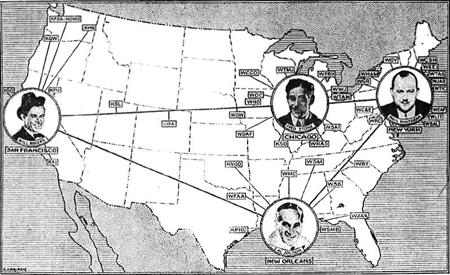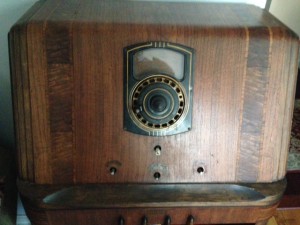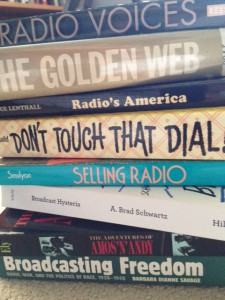Teaching Radio’s History

Map of NBC’s combined red, blue, orange, and gold networks in 1928.
Post by Bruce Lenthall, University of Pennsylvania
Teaching a media history course nearly 15 years ago, one day I found myself stumbling in search of a metaphor to help explain to undergraduates the network radio system that arose in the late 1920s.
“Think about network stations on television,” I suggested.
“What are network stations on TV?” the students asked. “How are they different than any other stations? How do you find them?”
“Do you remember those two knobs on a television?” I asked, trying to make this as simple and concrete as possible. Succeeding, instead, in showing my age. “Essentially, one knob let you change between the national channels, the network channels. When you turned the other knob, you changed channels among the local, non-network ones.”
There was a long pause.
Finally, with the air of one who has figured out something that has long confused her, a student spoke up. “This is really helpful,” she said. “My grandmother had a television with dials on it and I never could figure out what you used them for.”
 The point here is not the futility of trying to explain television knobs and dials to a generation in the age of the remote control. The point is not even my own occasional cluelessness about current cultural experiences. No, the real point here is about some of the challenges of teaching radio history.
The point here is not the futility of trying to explain television knobs and dials to a generation in the age of the remote control. The point is not even my own occasional cluelessness about current cultural experiences. No, the real point here is about some of the challenges of teaching radio history.
When I teach the history of radio – as I have done in a variety of course contexts from a media in history course to a history of American culture in the 1930s – I am routinely reminded that for undergraduate students, the basics of the early radio systems have long since been lost from cultural memory. Notions of national networks, of limitations on the number of stations – and with that, limitations on what audiences might hear and who might speak on the air – are unfamiliar. Even the metaphors a later generation might use to recall some of the early days of radio no longer have currency.
At the same time, though, other elements of the American system of broadcasting as it rose to prominence remain so entrenched in our deeply held assumptions that it can be hard for students to question them at all. For many of my undergraduates, commercially funded, for-profit broadcasting seems such a natural and positive way to organize media that it can be difficult for them to step out of such a system and examine it.
Such challenges are, of course, common ones for instructors: how to make the unfamiliar understandable and to understand the familiar by reexamining it through new eyes. And such challenges are why, in part, studying media history in general, and radio history in particular, is so powerful. Comprehending the unfamiliar media of the past can help us to see the familiar ones all around us anew. Digging into the history of broadcasting provides a comparative perspective – a comparison that enables us to see the system of our own time as distinct. Examining the historical comparison and the decisions that shaped past radio allows us to take what seems natural to us and to see it as something that has been constructed by choices – choices that could have been made differently. In turn, that perspective enables students to consider the benefits and costs of those choices.
As my classes explore the history of radio, we peer through three sets of lenses: the messages and content on the air, what radio meant to its listeners, and the structure of the industry. I ask my students, which frame of reference provides the most valuable insights into radio’s past? Invariably, my students say we need all three perspectives to really understand radio. That’s true, of course. But it also reveals how hard it is for novice scholars to take a stand. All of us who research radio know there are many valuable approaches to our work that we could take; but we also know that we have to pick one because we cannot do everything at once. My students are less comfortable choosing the approach that offers them the greatest insight.
 There is no question, though, which is the easiest area for them to discuss. The early radio programs may be foreign to students, but discussing those programs is not. When we talk about Amos ‘n’ Andy in the 1920s and 1930s, for instance, my students quickly understand the importance of talking about the program’s construction of race. They may not see the differences between the works we read by Melvin Ely and Michele Hilmes on this question at first, but they get there. This becomes an opportunity to consider factors that made radio so popular and the role racial othering played in the creation of a mass audience. Similarly, students are comfortable considering Orson Welles’s “War of the Worlds” as a potential critique of the media itself (OK, for that one, they also see Citizen Kane to help them unpack Welles’s views).
There is no question, though, which is the easiest area for them to discuss. The early radio programs may be foreign to students, but discussing those programs is not. When we talk about Amos ‘n’ Andy in the 1920s and 1930s, for instance, my students quickly understand the importance of talking about the program’s construction of race. They may not see the differences between the works we read by Melvin Ely and Michele Hilmes on this question at first, but they get there. This becomes an opportunity to consider factors that made radio so popular and the role racial othering played in the creation of a mass audience. Similarly, students are comfortable considering Orson Welles’s “War of the Worlds” as a potential critique of the media itself (OK, for that one, they also see Citizen Kane to help them unpack Welles’s views).
My students have a more difficult time considering what radio meant for its listeners. Here I have raised for them some of the issues I address in my own book. What did it mean to connect with far-flung and often-imagined others? To be part of a mass audience? Where did listeners find a sense of control and where did they lack it? Maybe I am too close to some of these questions or maybe others need to come first, but I’ve never fully gotten students to engage with them. Instead, I have repeatedly found my classes tacking to questions of what was on the air and, even more, the early structure of the industry.
That last one, the structure of radio, is particularly hard for students to understand. It is not just, as I have said, that the comparisons we might offer are both too unfamiliar and familiar for them. More than that, such structures themselves were – and are – often invisible and inaudible. I also wonder if, in the United States, we are not always comfortable thinking about economic motives and structures as something open for questioning. The idea that a radio system that prized commercial success and the pursuit of profit could be something we created, rather than the natural state of a society that values freedom, can be a jarring one. Exchange students from France and Germany in my classes have been quicker than many of their peers to envision means of funding media other than through advertising.
Because the centralized and commercial system of broadcasting is so hard to make plain to students, it is doubly difficult to present alternatives that existed. Alexander Russo has a detailed account of the structures that bolstered radio beyond the networks – an account I have never taught. How to showcase for students the limits of a structure, when the students do not know the structure itself?
Ultimately, understanding that structure requires students exercise imagination as much as analysis: visually representing radio’s complex reach, for instance, and, critically, imagining alternatives to a commercial network system.
In the end, though, the difficulties in teaching this material help make it so compelling. When students successfully come to terms with radio’s messages, meanings and structures, they take something opaque and make it their own, and they take something that is very much their own and find the distance to shine a light into it. Considering a host of historical media systems and critiques – hopefully – sets them up to decide what they value in, and to consider alternatives to, contemporary media as well.
And if, in the process, they learn that once upon a time, people changed channels by walking across the room and twisting a dial, well, so much the better.



A thought-provoking piece. Back in 2006 I began a blog, The Constant Viewer (now taken down, although I started a New Constant Viewer, one movie per year beginning in 1895), which imagined a single movie-goer who keeps a diary of the films he watches. I began it in 1876 (the diarist visits a camera obscura on the fairgrounds of the Philadelphia Centennial Exhibition) and ended in the present, more than 600 films total. I didn’t want to write about movies as artifacts but as what Robert Warshow famously called an “immediate experience.” Well, regardless of the effect of this on the reader, in traveling through the silent era I found myself more connected to the pre-1930 movie world in a way I’d never been. In fact, when I arrived at The Jazz Singer I was sorry to see the silents depart.
Short version: I agree with you that knowing the past involves more than a timeline of events/objects but also an exercise of imagination. My immersion in the project helped me break down certain barriers (although at 58, I certainly have much more experience than my own students of the look and feel and experience of the past century) and “to shine a light” into those “messages, meanings, and structures.” Thank you for an enlightening discussion of the challenges of exploring the “undiscovered country” of the past.